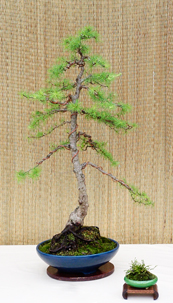Bonsai Tasks in February:
The winter season
is coming to a close.
Trees are
beginning to awaken
and begin another cycle
of growth. This signals
the start of a busy
time for bonsai enthusiasts.
This rebirth every
spring is regarded
by those of us immersed
in gardening as a miracle
of nature. By now,
you should have all
your supplies ready
for the repotting that
you are planning to
do this spring. Soil
should be mixed and
sifted. Pots should
be clean and screens
wired into the drainage
holes. If previous
years are an indication,
the window for repotting
your trees is quite
short. The more you
can get ready ahead
of time, the more time
you will have for actual
repotting.
Towards the end of the month you may be tempted to bring your bonsai out of storage. Be cautious! Those that have been stored in subdued light should be allowed a gradual transition to full outdoor exposure. Many of us follow a practice of moving bonsai outside during warm days and back inside at night or when temperatures dictate. Some type of wheeled conveyance is useful in this regard. Give your plants a final dormant oil or NEEM oil spray to prepare them for the beginning of bug season.
As always, check your pots for moisture. As the growth cycle begins, your trees will need more water, however, guard against over watering. Continue to protect trees from freezing winds. Avoid frost contact on early flowering trees. Shelter trees from heavy snow and excessive rainfall. Do Not fertilize your trees at this time.
In order to prepare you for "Spring" repotting, we need to be aware of and watch for the following. I stress here that "Spring" repotting doesn’t mean “calendar Spring” but the “Spring” for each individual tree. This may vary considerably depending on species, variety, area where grown and conditions of winter storage. In most cases, it is the deciduous trees that will give you the first indication that “spring” is approaching. For most deciduous trees the ideal time for repotting is when the leaf buds start to swell, but not yet opened into new leaves. This requires constant observation as we warm into spring. If they are hard and tight, it is too early. If you can see the green of unfolding new leaves, it’s too late. Most deciduous trees are so critical in the timing of repotting that these will probably be the first trees that you attend to. With conifers, Cedars, Spruces and Pines tend to be the earlier ones. Larches, Cryptomerias and Junipers tend to start later and can be put toward the end of your schedule.
As mentioned above, use the swelling of the new buds as a guide to ideal potting times. There are some exceptions and being aware of these can lighten your spring workload.
- Cotoneaster – late spring to summer during the growing season.
- Quince – best in autumn
- Pomegranate – later in spring after leaves open
- Chinese Elm – may be root pruned later than most deciduous trees
- Figs – April to July
- Gardenia – late spring
- Camellia – autumn repotting or after flowering
- Serissas – these are not critical, repot in late spring
- Chamaecyparis – anytime except mid winter and mid summer
- Juniper Procumbens – anytime
If repotted at the correct time, most deciduous trees will withstand drastic root pruning. Conifers should be cut less drastically, removing approximately 1/3 of the roots. Most deciduous trees are also top pruned at this time, removing winter die-back and pruning for style. Conifers are pinched and pruned later in the spring.
Do not attempt to wire and shape your trees AFTER repotting. The tree, even though it is wired into the pot, has not established it’s root system and the fine roots just emerging will be easily damaged. If you are going to wire, it should be done prior to repotting.
Later in the month you may be tempted, by a few warm days, to bring trees out of winter storage. Be cautious. Trees that have been stored in subdued light may burn when exposed to direct sun. Allow for a gradual transition.

